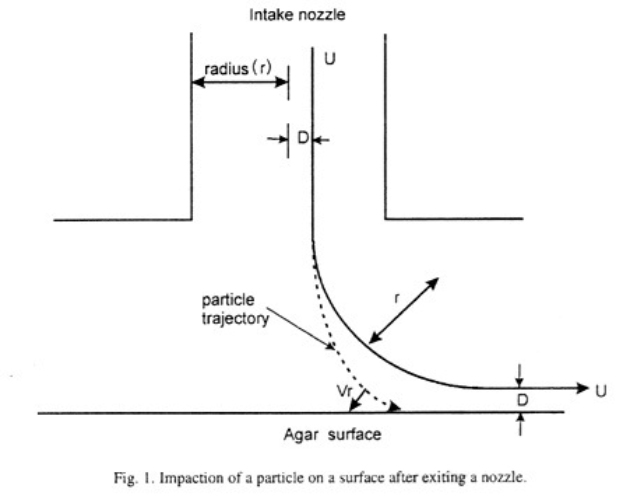Application Note – Bioaerosol N.23 – Principle of microbial collection on agar surface by active air sampler

Principle of an active microbial air sampler
Air containing microbe-carrying particles is aspirated and accelerate through a hole and direct towards a nutrient agar surface of a plate. As the air turns away from the agar surface, the microbe-carrying particles that cannot follow the flow are impacted. The plate containing nutrient agar is then incubate at a suitable time and temperature, and the resulting Colony Forming Units (CFU) are counted to evaluate the number of microbe-containing particles collected from a specific volume of air.
How the microbe-carrying particles impact on agar surface
The aspirated air passes through an intake orifice of the sampler head at a velocity of “U” and, as it approaches the agar surface, it turns. The arc of the turning circle has a radius of “r” which is assumed to be the same as the radius of the intake nozzle. The velocity round the curve is assumed to be “U”.
The microbe-carrying particle travels along the streamline and experiences a centrifugal force that causes it to move toward the agar surface of the plate.

The collection efficiency calculation
The collection efficiency “E” is calculated by the formula:
π.U p d2.C
E = —— ( ———- )
2.r 18 η
Where:
“U” is the velocity of the air through the nozzle
“r” is the radius of the curvature of the streamline
“p” is the density of microbe-carrying particles (1100 Kg/cubic metre)
“d” is the equivalent particle diameter
“C” is the Cunningham slip factor
“n” is the viscosity of room air at 20°C (1.81 x 10-5 Pa x s).
The collection efficiency of an air sampler can be calculated by the above formula and then the d50 “cut-off” size. The d50 size is often used to describe the impact efficiency of a sampler, it being the particle size at which 50% of the particles are collected and 50% pass through the sampler because they are too small to impact.
The sizes of environmental micro-organisms
The normal size range of environmental airborne microorganisms is 4-20 microns. Never less, some research works for biological aerosol, where single cell aerosol are used, require the ability to collect micro-organisms up to 1 micron.

















